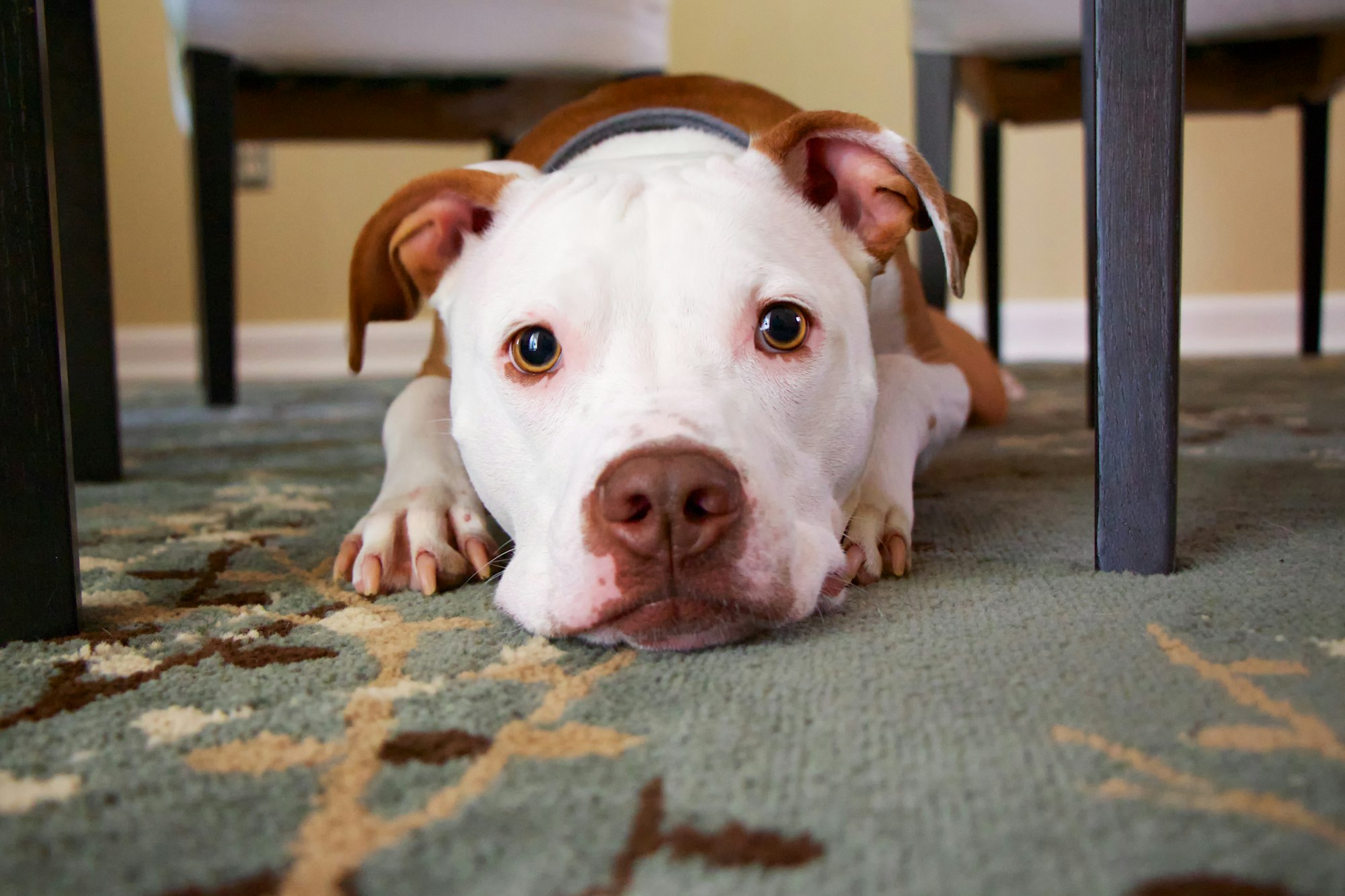Dog whining is a common vocalization that dogs use to communicate their needs, emotions, and discomfort. It is important for dog owners to understand why dogs whine and how to address it effectively. According to a study conducted by animal behaviorist Dr. Stanley Coren, dogs whine for various reasons, including communication, attention-seeking, anxiety or stress, and discomfort or pain.

Common reasons for dog whining include hunger, the need to go outside, boredom or loneliness, and fear or distress. It is crucial for dog owners to identify the underlying cause of their dog's whining in order to address it appropriately.
To stop dog whining, several strategies can be employed. Firstly, identifying the cause of whining is essential. This involves observing the context and triggers of the whining behavior. Secondly, addressing the basic needs of the pup, such as providing dog food, water, and bathroom breaks, can help alleviate whining. Thirdly, mental and physical stimulation through play, exercise, and interactive dog toys can keep dogs engaged and reduce whining. Positive reinforcement training techniques can also be utilized to teach dogs alternative behaviors and reward desired responses. Finally, consistency and patience are key in modifying dog whining behavior.
In some cases, professional help may be needed to address excessive or persistent dog whining. Consulting a veterinarian or a certified animal behaviorist can provide additional guidance and support in understanding and managing the underlying causes of whining.
By gaining a deeper understanding of dog whining and employing appropriate strategies, dog owners can create a harmonious and communicative relationship with their canine companions.

Key takeaways:
- Understanding dog whining: Whining is a form of communication for dogs and can indicate various needs or emotions, such as attention-seeking, anxiety, discomfort, or pain.
- Common reasons for dog whining: Dogs may whine due to hunger, the need to go outside, boredom, loneliness, fear, or distress.
- How to stop dog whining: To address dog whining, identify the cause, address basic needs, provide mental and physical stimulation, use training and positive reinforcement, and be consistent and patient. Seeking professional help may be necessary in some cases.
Understanding Dog Whining
Understanding why dogs whine is essential for pet owners to acknowledge their needs. Dog whining serves as a crucial method of communication, enabling dogs to transmit various messages. It can act as an indication of hunger, discomfort, fear, or a desire for attention. By carefully observing their body language and accompanying behavior, owners can effectively interpret the underlying meaning conveyed through the whining.
For instance, if a dog engages in pacing and whining, it may signify anxiety or restlessness. Gaining a comprehensive understanding of dog whining empowers owners to respond appropriately, catering to their pet's requirements and ensuring their overall comfort and well-being.
Why Do Dogs Whine?
Whining is a common behavior among dogs, and understanding why they do it can offer valuable insights into their needs and emotions. In this section, we'll dive into the reasons behind a dog's whining behavior, exploring various factors such as communication, attention-seeking, anxiety or stress, and discomfort or pain. By unraveling the motivations behind their whining, we can better care for our furry friends and strengthen our bond with them.
1. Communication
Communication is an imperative element of dog whining. Dogs utilize whining as a means of expressing their needs, emotions, and desires. It functions as a form of canine vocal communication. By comprehending the diverse types of whining and their meanings, dog owners can better interpret the messages of their pets.
Whining can indicate the necessity for attention, convey discomfort or pain, signify signify anxiety or stress, and express fear or distress. It is crucial for pet owners to pay attention to the context and accompanying behaviors to discern the underlying cause of their dog's whining.
2. Attention-seeking
Attention-seeking is one of the common reasons why dogs whine. Dogs may whine to seek attention from their owners when they want to play, go for a walk, or simply be acknowledged. This behavior is often observed in dogs who have learned that whining can get them the attention they desire. To stop dogs' attention-seeking whining, it is important not to give in to their demands and only reward them when they are calm and quiet. Instead, divert their focus by engaging them in activities or providing them with toys or puzzles to keep them entertained.
3. Anxiety or Stress
Anxiety or stress can be common causes of dog whining. Dogs may experience anxiety or stress in various situations that make them feel overwhelmed or uneasy. Some examples of these situations include being left alone, encountering loud noises, or being in unfamiliar environments. To effectively address the whining caused by anxiety or stress, it is essential to identify the underlying cause and take appropriate measures to tackle it.
This can involve providing comfort, using calming tools or techniques, and seeking professional help if necessary. By creating a calm and secure environment for your dog, you can effectively alleviate their anxiety and reduce excessive whining.
4. Discomfort or Pain
Discomfort or pain is one of the common reasons why dogs whine. It's important to identify the cause of their discomfort or pain to provide appropriate care and relief.
- Joint pain: Arthritis or other joint issues can cause dogs to whine. Consult a vet for proper diagnosis and treatment.
- Digestive problems: Upset stomach or gastrointestinal issues can lead to discomfort and whining. Adjust their diet or seek veterinary advice.
- Bladder problems: Dogs with bladder infections or urinary tract issues may whine due to discomfort. Check for signs of frequent urination or accidents.
- Other medical issues: Various medical conditions such as dental problems, injuries, or infections can cause dogs to whine. Seek immediate veterinary attention.
Common Reasons for Dog Whining
Dog whining can be quite a puzzle to decipher, but fear not! In this section, we'll dive into the common reasons behind this vocalization. From their rumbling stomachs to the desperate need to go outside, boredom or loneliness, and even fear or distress, we'll explore the various factors that prompt our furry friends to communicate through whining. So, grab a treat and get ready to uncover the fascinating insights into our beloved dogs' whining habits!
1. Hunger
When a dog whines out of hunger, it serves as an important reminder that its fundamental needs are not being fulfilled. It is absolutely vital for dog owners to consistently offer well-balanced meals in order to prevent hunger-related whining. This can be achieved by adhering to a regular feeding schedule and ensuring that the dog's diet satisfies its nutritional requirements.
By monitoring the dog's weight and seeking advice from a veterinarian, appropriate portion sizes can be determined. Additionally, incorporating interactive toys or treat-dispensing puzzles during mealtime can mentally engage the dog, thereby reducing the likelihood of excessive whining caused by hunger.
2. Need to Go Outside
When dogs whine, it could indicate that they have a need to go outside. This is one of the common reasons for their vocalization. It is crucial to pay attention to their whining behavior and understand their needs. If your dog is persistently whining, it is essential to identify the cause and address it accordingly. Providing regular opportunities for bathroom breaks and establishing a consistent routine can help prevent excessive whining due to the need to go outside. By understanding your dog's communication and providing proper training and reinforcement, you can effectively manage their whining behavior.

3. Boredom or Loneliness
Dogs may whine out of boredom or loneliness, seeking attention and companionship.
- Insufficient stimulation: Lack of mental and physical exercise can lead to boredom, resulting in excessive whining.
- Separation anxiety: Dogs with separation anxiety may whine when left alone, as they feel lonely and anxious.
- Lack of social interaction: Dogs are social animals and may whine when they crave attention or desire companionship.
- Need for mental stimulation: Dogs may whine when they are not mentally challenged or stimulated enough.
4. Fear or Distress
When a dog whines, it could be a sign of fear or distress. Understanding the underlying cause is crucial in addressing this behavior. Here are some common reasons for a dog's fear or distress:
| Reasons for Dog's Fear or Distress |
|---|
|
To address dog whining caused by fear or distress, follow these steps:
| Steps to Address Dog Whining |
|---|
|
If the problem persists, seeking professional help may be necessary.
How to Stop Dog Whining?
Is your dog's constant whining driving you crazy? Don't worry, we've got you covered. In this section, we'll uncover the secrets to stopping dog whining once and for all. From identifying the root cause of the whining to addressing your furry friend's basic needs, providing mental and physical stimulation, implementing training techniques, and practicing consistency and patience – we've got a range of effective strategies up our sleeves. Get ready to enjoy a quiet and contented canine companion in no time!
1. Identify the Cause of Whining
Identifying the cause of your dog's whining is crucial in addressing their needs and providing appropriate solutions. Four common reasons for dog whining include hunger, the need to go outside, boredom or loneliness, and fear or distress. To determine the cause, observe your dog's behavior and check for any physical discomfort or pain.
Once you identify the cause, take the following steps: address basic needs, provide mental and physical stimulation, use training and positive reinforcement, and maintain consistency and patience. If the whining persists or is accompanied by excessive drooling or other concerning symptoms, it is advisable to seek professional help from a veterinarian.
I once had a dog who would constantly whine whenever I left the house. After identifying the cause of her whining, which was a fear of being left alone, I addressed this issue by gradually desensitizing her to my departures, using calming tools, and enrolling her in trick training classes. Through reward-based training techniques and consistency, her whining gradually decreased, and she became more confident in my absence.
2. Address Basic Needs
Addressing the basic needs of your dog is crucial in minimizing their whining behavior. Here are some essential steps to consider:
1. Address Basic Needs: Ensure that your dog is provided with proper nutrition, such as a balanced and nutritious diet, to prevent hunger-related whining.
Make sure to give your dog regular bathroom breaks, allowing them opportunities to go outside and alleviate any discomfort or whining.
3. Address Basic Needs: Engage your dog in both mental and physical stimulation activities on a regular basis. This will help prevent boredom and restlessness, which can contribute to whining.
4. Address Basic Needs: Train your dog using positive reinforcement techniques to establish rules and boundaries. This approach promotes a sense of security, reducing anxiety and minimizing whining behavior.
5. Address Basic Needs: Stick to a consistent daily routine to provide structure and predictability for your dog. Consistency and routine can help alleviate anxiety and reduce whining.
By effectively addressing these basic needs, you can significantly minimize whining behavior in your dog.
3. Provide Mental and Physical Stimulation

- To provide mental and physical stimulation for your dog, engage in interactive play sessions, such as fetch or tug-of-war, to stimulate your dog's physical activity.
- Create a routine for daily walks or runs to provide mental and physical exercise.
- Provide puzzle toys, treat-dispensing toys, or interactive feeding toys to challenge your dog's problem-solving skills and keep them mentally stimulated.
- Teach your dog new tricks or commands through obedience training or trick training classes to keep their mind active.
- Arrange playdates with other dogs to provide social interaction and mental stimulation.
- Explore different environments and take your dog on outings to expose them to new sights, smells, and sounds.
4. Training and Positive Reinforcement
Training and positive reinforcement are effective methods to address dog whining behavior. Here are some steps to follow:
- Identify the cause of whining, such as discomfort or anxiety.
- Address basic needs like hunger, bathroom breaks, and exercise.
- Provide mental and physical stimulation through interactive toys and playtime.
- Train your dog using training and positive reinforcement techniques, rewarding desired behaviors.
- Be consistent in your approach and patient with your dog's progress.
Using these methods can help your dog overcome whining habits and promote better communication. Did you know that dogs are highly responsive to positive reinforcement and thrive in environments with clear training structures?
5. Consistency and Patience
Consistency and patience are key when addressing dog whining behavior. Use a consistent approach to training and be patient with your dog's progress. Here are some tips:
- Establish clear rules and boundaries for your dog to follow.
- Consistently reinforce desired behaviors and discourage whining.
- Be patient and avoid giving in to your dog's whining demands.
- Reward your dog when they are calm and quiet, reinforcing the desired behavior.
- Stick to a consistent routine to provide your dog with a sense of stability.
Consistency and patience are crucial elements when dealing with the issue of dog whining. It is important to adopt a consistent training approach and maintain patience while observing your dog's progress. The following tips can be helpful:
- Establishing clear rules and boundaries is essential for your dog to follow.
- Consistently reinforcing desired behaviors and discouraging whining is vital.
- It is advisable to be patient and avoid giving in to your dog's whining demands.
- Rewarding your dog when they exhibit calm and quiet behavior will reinforce the desired conduct.
- Sticking to a consistent routine will provide your dog with a sense of stability.
When to Seek Professional Help?
When your dog is whining excessively, it can be difficult to determine when professional help is needed. Some signs that indicate it may be time to seek help include persistent whining that is not improving with training, sudden changes in behavior accompanied by whining, or if the whining is accompanied by signs of pain or distress. If you have tried various interventions and nothing seems to work, consulting a professional can provide you with the guidance and expertise needed to address the issue effectively.
Pro-tip: Remember that seeking professional help is always a valid option when dealing with any behavioral concerns in your dog.

Frequently Asked Questions
- Why do dogs whine?
- Dogs may whine for various reasons, such as communicating their desires, excitement, pain, and stress. They can use whining as a way to ask for something, seek attention, express excitement, show boredom, indicate pain or discomfort, or indicate stress.
- How can I determine the reason for my dog's whining?
- To determine the reason for your dog's whining, pay close attention to the sound of the whining and any accompanying behaviors. Whining accompanied by appeasement gestures may indicate anxiety or fear, while whining for attention or boredom may indicate a need for exercise or mental stimulation. If there is no apparent reason for the whining, a vet visit is recommended to check for underlying health issues.
- What should I do if my dog is whining due to stress or pain?
- If your dog is whining due to stress or pain, it's important to approach them gently and handle them with care. Take a step-by-step approach to address the situation and consult a vet if necessary. Additionally, Pet Releaf CBD products are recommended to help dogs with stress, anxiety, and other issues.
- Why does my dog whine during greetings?
- Some dogs may whine during greetings as a result of excitement. This greeting behavior can be managed through positive reinforcement training techniques, such as reward-based training. It's important to stay calm and not encourage the behavior excessively.
- How can I stop my dog from whining for desired objects?
- If your dog whines for desired objects, it is important to establish clear pack rules and boundaries. Using reward-based training techniques and teaching the "leave it" command can help discourage this behavior. Ignoring the whining and walking away can signal to the dog that their whining will not be rewarded.
- What can I do if my dog's whining becomes a habit?
If your dog's whining becomes a habit or persists for long periods, seeking professional help from a dog training expert or attending obedience classes can be beneficial. These programs can provide guidance on addressing whining and improving overall obedience and behavior.




